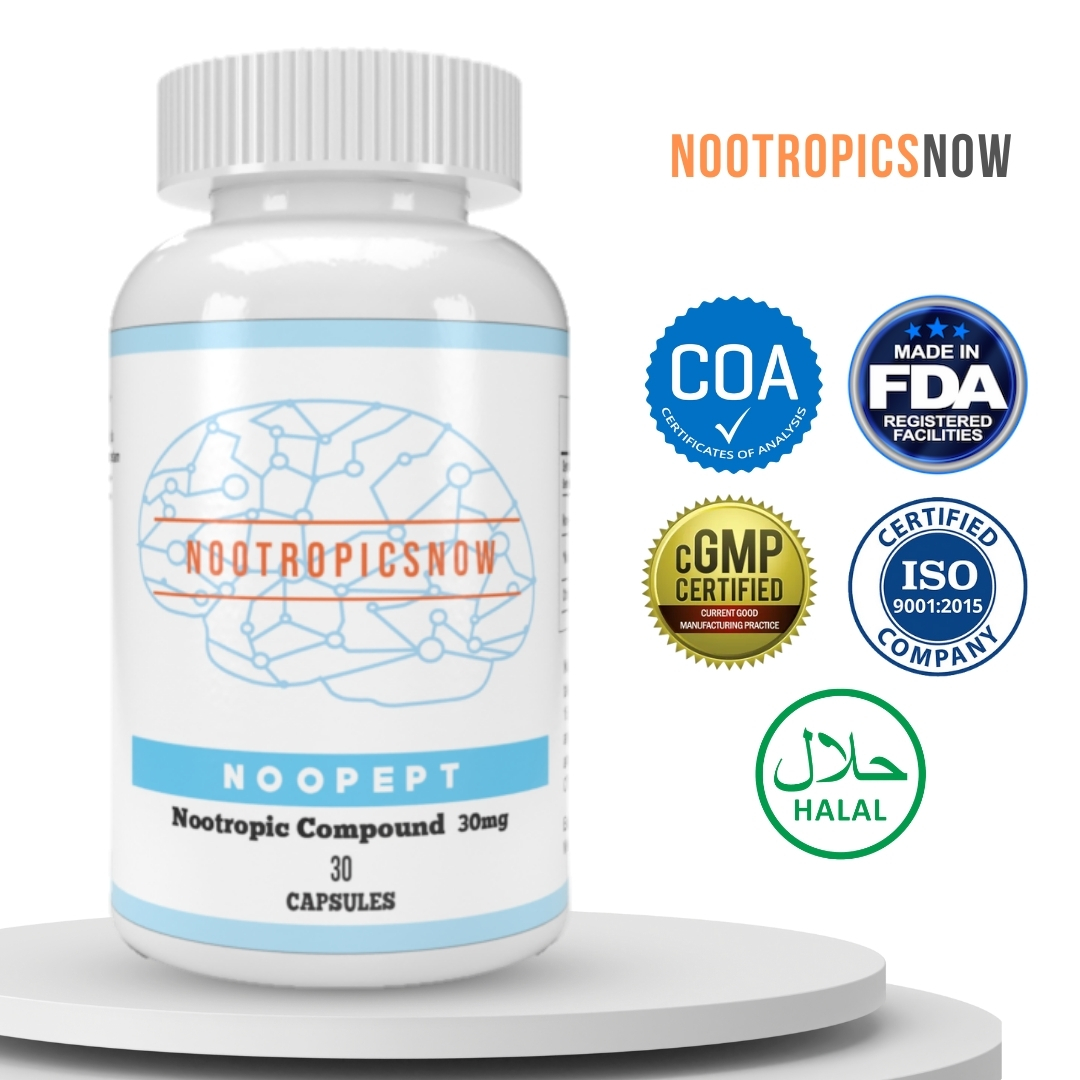Noopept Half-Life: Effects & Dosage

Half-Life of Noopept: Understanding its Duration of Action
Noopept, also known as N-phenylacetyl-L-prolylglycine ethyl ester, is a popular synthetic nootropic celebrated for its cognitive-enhancing properties. Individuals use this smart drug to improve memory, focus, and learning capacity. However, a comprehensive understanding of Noopept’s pharmacokinetics, particularly its half-life, is crucial for optimizing dosage and anticipating its effects. Therefore, this section delves into the half-life of Noopept and its implications for users.
Defining Half-Life: A Pharmacokinetic Overview
The term “half-life” in pharmacology refers to the time it takes for the concentration of a drug in the body to reduce by half. This metric is essential for determining dosing intervals, predicting drug accumulation, and understanding how long a drug’s effects will last. Indeed, a drug with a short half-life requires more frequent dosing to maintain consistent therapeutic levels, whereas a drug with a long half-life may only need to be administered once daily. Consequently, understanding a drug’s half-life enables users to optimize their regimen.
Noopept’s Half-Life: A Comparative Analysis

The half-life of Noopept differs based on various factors, including the species studied (animal vs. human) and the method of administration. While the parent drug, Noopept, itself has a relatively short half-life, its primary metabolite, cycloprolylglycine, plays a significant role in its overall effects.
Half-Life in Rodents
Studies conducted on rodents (rats and mice) indicate a significantly shorter half-life for Noopept. Specifically, researchers have found that Noopept’s half-life in rodents ranges from approximately 5 to 16 minutes. For instance, one study reported a half-life of about 5-10 minutes, while another observed a half-life of around 16 minutes in rats. Therefore, these rapid elimination rates highlight the relatively quick metabolism of Noopept in these animal models.
Half-Life in Humans
In contrast to the findings in rodents, human studies suggest a longer half-life for Noopept, approximately 30 to 60 minutes. Consequently, this longer duration implies that Noopept remains in the human body for a more extended period compared to rodents, potentially impacting the frequency and duration of its effects.
It’s important to select a high-quality Noopept supplement to ensure efficacy.

View Product
The Role of Cycloprolylglycine
It’s critical to consider the role of cycloprolylglycine, Noopept’s primary metabolite. Although Noopept itself has a short half-life, this metabolite possesses its own pharmacological activity and contributes substantially to the overall nootropic effects. Indeed, cycloprolylglycine is believed to exert its cognitive-enhancing effects by influencing the levels of neurotrophic factors, such as Brain-Derived Neurotrophic Factor (BDNF).
Furthermore, while the exact half-life of cycloprolylglycine hasn’t been definitively established in human studies, it is believed to be longer than that of Noopept. Thus, this extended presence in the brain allows for sustained modulation of cognitive processes.
Factors Influencing Noopept’s Half-Life
Several factors can influence the half-life of Noopept, including:
Practical Implications for Users
Understanding Noopept’s half-life has significant practical implications for individuals considering its use:
Noopept Dosage and Administration
The standard dosage of Noopept typically ranges from 10 to 30 mg per day, divided into multiple administrations. Some users prefer sublingual administration for faster absorption, while others opt for oral ingestion.
Sublingual Administration
Sublingual administration involves placing Noopept under the tongue, where it dissolves and is absorbed directly into the bloodstream. This route bypasses the first-pass metabolism in the liver, potentially leading to faster and more efficient absorption.
Oral Ingestion
Oral ingestion involves swallowing Noopept in capsule or powder form. The drug is then absorbed through the digestive system and metabolized in the liver before reaching the bloodstream.
Users should experiment with different administration routes to determine which one works best for them. However, starting with lower doses and gradually increasing as needed is advisable, regardless of the chosen route.
Potential Side Effects and Safety Considerations
While Noopept is generally considered safe, some users may experience side effects, especially at higher doses. These side effects can include:
Individuals with pre-existing medical conditions, particularly liver or kidney issues, should exercise caution when using Noopept. Furthermore, pregnant or breastfeeding women should avoid Noopept due to a lack of safety data in these populations.
It is essential to consult with a healthcare professional before starting Noopept, especially if you are taking other medications. This is because drug interactions can occur and potentially alter the half-life and effects of Noopept.
Long-Term Effects and Tolerance
Limited research exists on the long-term effects of Noopept. Some users report developing tolerance over time, requiring higher doses to achieve the same cognitive-enhancing effects. To mitigate tolerance, cycling Noopept—taking it for a period followed by a break—is often recommended. Typical cycles range from a few weeks to a few months, followed by a break of similar duration. However, more research is needed to understand the optimal cycling strategy and long-term effects.
Alternative Nootropics
For individuals seeking alternatives to Noopept, several other nootropics are available, each with its unique mechanism of action and half-life:
For improved cognitive function, consider Lion’s Mane Mushroom.

View Product
Users should research and carefully consider their individual needs and preferences when selecting an alternative nootropic. Furthermore, consultation with a healthcare professional is recommended before starting any new supplement regimen.
The Future of Noopept Research
Ongoing research continues to explore the mechanisms of action, long-term effects, and therapeutic potential of Noopept. Future studies may provide more detailed insights into its pharmacokinetics, including the half-life of its metabolites and the factors that influence its metabolism. Understanding these aspects is crucial for optimizing the use of Noopept and maximizing its cognitive-enhancing benefits.
Specifically, future research should focus on:
These research endeavors will contribute to a more comprehensive understanding of Noopept and its role in cognitive enhancement.
Noopept and Cognitive Decline
While most users seek nootropics for cognitive enhancement, research also explores their potential in mitigating age-related cognitive decline. Therefore, Noopept has shown promise in animal models in protecting against neuronal damage. Further, its effects on neurotrophic factors, like BDNF, have led researchers to investigate its possible therapeutic use in conditions like Alzheimer’s disease. While the findings are preliminary and human trials are necessary, Noopept’s potential role in slowing cognitive decline is a promising area of research.
For supporting overall brain health, consider Alpha-GPC.

View Product
Regulations and Legal Status
The legal status of Noopept varies by country. In some regions, it is available as a dietary supplement, while in others, it may require a prescription. Therefore, users should be aware of the regulations in their respective countries before purchasing or using Noopept. Moreover, ensure to purchase Noopept from reputable sources to guarantee its authenticity and purity. The regulatory landscape surrounding nootropics is continuously evolving, so staying informed is essential.
Conclusion: Maximizing Noopept’s Benefits
The half-life of Noopept is an important factor to consider when optimizing its use. While the parent compound has a relatively short half-life, its active metabolite, cycloprolylglycine, contributes to its overall effects. Understanding the factors that influence Noopept’s half-life, along with individual responses and safety considerations, is essential for maximizing its cognitive-enhancing benefits. As research continues, a more detailed understanding of Noopept’s pharmacokinetics and long-term effects will further refine its use in cognitive enhancement. By staying informed and consulting with healthcare professionals, users can safely and effectively harness the potential of Noopept and other nootropics to enhance their cognitive performance.
Half-Life of Noopept
Understanding the pharmacokinetic properties of any drug, including its half-life, is essential for optimizing its use and maximizing its benefits. For Noopept, a popular synthetic nootropic, this understanding is particularly important due to its unique mechanism of action and rapid metabolism. The half-life dictates how frequently one must administer the substance to maintain a consistent level of effect. Therefore, let’s examine the half-life of Noopept in detail.
Defining Half-Life in Pharmacology
In pharmacology, half-life refers to the time it takes for the concentration of a drug in the body to be reduced by half. This metric is crucial because it determines the duration of a drug’s effects and how often it needs to be administered to maintain a therapeutic level in the body. Several factors influence the half-life of a drug. These factors include metabolic rate, distribution throughout the body, and excretion pathways. Therefore, understanding half-life is vital for dosing, treatment planning, and minimizing potential side effects.
Noopept’s Half-Life: Species-Specific Variations
The half-life of Noopept varies across different species. Consequently, translating research findings directly from animal models to humans requires careful consideration. Here’s a detailed breakdown:
| Species | Half-Life (minutes) | Notes |
|---|---|---|
| ——– | ——————- | —————————————————————————————————– |
| Rodents | 5-10 | Rapid metabolism; findings may not directly translate to humans. |
| Rats | ~16 | Study didn’t measure cycloprolylglycine serum levels, the active metabolite. |
| Humans | 30-60 | Longer half-life than in rodents; still considered relatively short compared to other substances. |
The Role of Cycloprolylglycine: A Crucial Metabolite
While Noopept has a short half-life, it significantly increases the concentration of its primary metabolite, cycloprolylglycine. This metabolite is believed to be responsible for Noopept’s longer-term nootropic effects. Even though Noopept itself is quickly metabolized, cycloprolylglycine can persist in the brain for an extended period, sustaining cognitive enhancement.

View Product
Consequently, the effects of Noopept extend beyond its brief presence in the bloodstream. This dynamic highlights the importance of considering both the parent drug and its metabolites when assessing the overall impact of a nootropic substance. Cycloprolylglycine acts on AMPA receptors. These receptors are crucial for synaptic plasticity and long-term potentiation (LTP), processes fundamental to learning and memory. By modulating AMPA receptor activity, cycloprolylglycine enhances the brain’s capacity for forming new connections and consolidating memories.
Implications for Dosing and Frequency
Given Noopept’s short half-life, frequent dosing may be necessary to maintain consistent cognitive benefits.
View Product-Nootropic-Brain-Focus-Memory-Booster-Supplement-Neuropro-i.202321183.4051573042)
Most users administer Noopept multiple times throughout the day to achieve this. However, the optimal dosing frequency can vary depending on individual metabolism, sensitivity, and desired effects. Some users find that taking Noopept twice a day is sufficient, while others prefer three or more doses to maintain a stable cognitive boost.
Therefore, experimentation and careful observation are crucial in determining the most effective dosing schedule. Users should start with a lower dose and gradually increase it while monitoring their response. It’s also essential to consider the potential for tolerance development with frequent use, which may necessitate cycling the nootropic to maintain its effectiveness.
Factors Influencing Noopept’s Half-Life
Several factors can influence the half-life of Noopept. These factors include individual metabolic rates, liver function, and kidney function. Individuals with faster metabolic rates may process Noopept more quickly, resulting in a shorter half-life. Conversely, those with impaired liver or kidney function may experience a prolonged half-life due to reduced clearance.
Furthermore, other substances consumed concurrently can affect Noopept’s metabolism. Some drugs or supplements may inhibit or induce the enzymes responsible for Noopept metabolism, altering its half-life. It is crucial to consider these potential interactions when combining Noopept with other substances to avoid unexpected effects or adverse reactions.
Noopept’s Bioavailability
Bioavailability refers to the fraction of an administered dose of a drug that reaches the systemic circulation unchanged. For Noopept, bioavailability can vary depending on the route of administration. Sublingual administration, where the drug is placed under the tongue, can enhance bioavailability by bypassing first-pass metabolism in the liver. Intranasal administration, delivering the drug directly into the nasal cavity, is another method to improve bioavailability. Oral administration, while convenient, may result in lower bioavailability due to metabolism in the digestive system and liver. Understanding the bioavailability of Noopept through different routes is essential for optimizing dosing and achieving the desired cognitive effects.
Practical Considerations for Noopept Users
For individuals considering or currently using Noopept, several practical considerations should be kept in mind:
Potential Interactions and Contraindications
Although Noopept is generally considered safe, potential interactions and contraindications should be considered. Noopept may interact with anticoagulants or antiplatelet drugs, increasing the risk of bleeding. Individuals with bleeding disorders or those taking blood-thinning medications should exercise caution and consult with a healthcare professional before using Noopept. Furthermore, Noopept may have interactions with other nootropics or stimulants, leading to overstimulation or adverse effects.
It is crucial to research potential interactions and avoid combining Noopept with substances that may have synergistic or antagonistic effects. Individuals with liver or kidney problems should use Noopept with caution, as these conditions can affect its metabolism and clearance. Pregnant or breastfeeding women should avoid Noopept due to limited safety data.
Future Research Directions
Further research is needed to fully elucidate the pharmacokinetic properties of Noopept. Specifically, more studies are required to measure the serum levels of both Noopept and its metabolite, cycloprolylglycine, in humans. This will provide a more accurate understanding of their respective half-lives and their contributions to the overall cognitive effects. Additionally, studies are needed to investigate the effects of various factors, such as age, genetics, and concurrent medications, on Noopept metabolism. This research can help identify individuals who may be more or less responsive to Noopept and allow for personalized dosing strategies. Moreover, studies are needed to assess the long-term safety and efficacy of Noopept use, particularly with regard to tolerance development and potential adverse effects.
The Importance of Responsible Use
As with any nootropic or drug, responsible use is essential for maximizing benefits and minimizing risks. This includes adhering to recommended dosages, monitoring for adverse effects, and cycling the substance to prevent tolerance.
View Product-Nootropic-Brain-Focus-Memory-Booster-Supplement-Neuropro-i.202321183.4051573042)
Furthermore, it is crucial to maintain a healthy lifestyle that supports cognitive function, including a balanced diet, regular exercise, and sufficient sleep. Nootropics like Noopept should be viewed as tools to enhance cognitive performance, not as replacements for healthy habits.
By combining responsible use with a holistic approach to cognitive enhancement, individuals can optimize their mental capabilities and achieve their full potential. Additionally, users should remain informed about the latest research findings and adapt their practices accordingly to ensure the safest and most effective use of nootropic substances.
In conclusion, understanding the half-life of Noopept, along with its metabolite cycloprolylglycine, is crucial for optimizing its use. While Noopept has a short half-life, its metabolite contributes to longer-term cognitive effects, influencing dosing frequency and overall efficacy. Responsible use, combined with ongoing research and personalized approaches, is key to unlocking the cognitive benefits of Noopept while minimizing potential risks.


